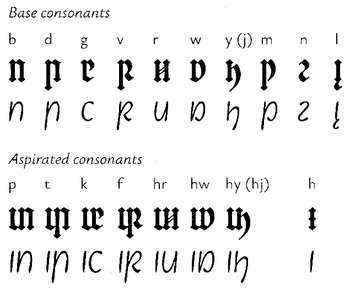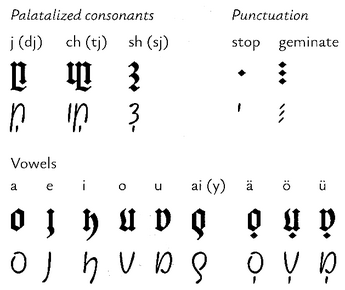Appendix:Fjerdan orthography: Difference between revisions
| Line 7: | Line 7: | ||
The script has letters for aspirated (voiceless) consonants which are formed off of the base (voiced/unaspirated) consonant glyphs in a predictable manner. There are also glyphs for palatalized (postalveolar) consonants similarly formed off of the glyphs of the corresponding alveolar sounds. This makes the system partly {{w|featural}}. | The script has letters for aspirated (voiceless) consonants which are formed off of the base (voiced/unaspirated) consonant glyphs in a predictable manner. There are also glyphs for palatalized (postalveolar) consonants similarly formed off of the glyphs of the corresponding alveolar sounds. This makes the system partly {{w|featural}}. | ||
===Diachronic evolution=== | ===Diachronic evolution=== | ||
| Line 30: | Line 25: | ||
[[File:Fj3.png|345px|top]] | [[File:Fj3.png|345px|top]] | ||
====Usage notes==== | |||
The Fjerdan script is young and thus still mostly phonetic, with a few exceptions: | |||
* Voiceless consonants can be written with the corresponding base (voiced) letter in unvoiced clusters or word-finally. This reduces visual clutter. For example, {{m|fjer|strüpfet}} could be written in Fjerdan script as ''sdrüpved''. | |||
* The gemination mark is mostly used for disambiguation of minimal pairs, and is not used otherwise. For example, {{m|fjer|ulle}} is written as ''ule'', while {{m|fjer|verret}} is written with the gemination mark to distinguish it from {{m|fjer|veret}}. | |||
* The sound ''zh'' [ʒ] is an allophone of the phoneme ''y'' /j/, and is consequently spelled the same. For example, {{m|fjer|nezh}} is spelled ''ney'' and {{m|fjer|aizhor}} is spelled ''ayor''. Compare this with {{m|fjer|yarl}}, which is spelled with the same ''y'' glyph. | |||
===Numerals=== | ===Numerals=== | ||
Revision as of 05:14, 16 November 2024
The Fjerdan language is written with an alphabet created by Christian Thalmann for the potential spin-off series of Netflix's Shadow and Bone, Six of Crows, which did not end up being created.
Orthography
Fjerdan is written with an alphabet. As such, it features full characters for both consonants and vowels.
The script has letters for aspirated (voiceless) consonants which are formed off of the base (voiced/unaspirated) consonant glyphs in a predictable manner. There are also glyphs for palatalized (postalveolar) consonants similarly formed off of the glyphs of the corresponding alveolar sounds. This makes the system partly featural.
Diachronic evolution
Over the course of its history, the Fjerdan script evolved through many styles and writing mediums (the phrase Skirden Fyerda is used as an example}}:
From top to bottom: wood runes, vernacular handwriting, calligraphic blackletter, utilitarian blackletter, rectangular blackletter, and grotesque/sans serif.
Letters and punctuation
The Fjerdan letters for consonant and vowel sounds as well as punctuation marks are shown below:
s
Usage notes
The Fjerdan script is young and thus still mostly phonetic, with a few exceptions:
- Voiceless consonants can be written with the corresponding base (voiced) letter in unvoiced clusters or word-finally. This reduces visual clutter. For example, strüpfet could be written in Fjerdan script as sdrüpved.
- The gemination mark is mostly used for disambiguation of minimal pairs, and is not used otherwise. For example, ulle is written as ule, while verret is written with the gemination mark to distinguish it from veret.
- The sound zh [ʒ] is an allophone of the phoneme y /j/, and is consequently spelled the same. For example, nezh is spelled ney and aizhor is spelled ayor. Compare this with yarl, which is spelled with the same y glyph.
Numerals
The Fjerdan numeral system is base-10, with a sub-base of 5. It is shown below:



